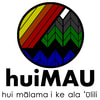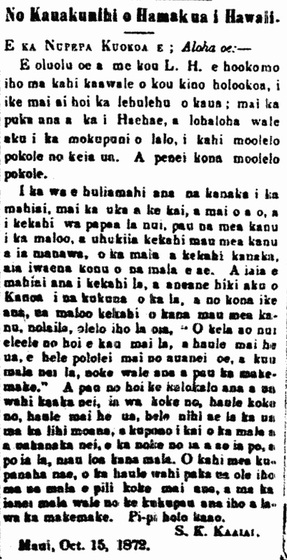Return to Hāmākua
Hāmākua : Moʻolelo
Nūpepa ʻŌlelo Hawaiʻi
Our kūpuna recorded many of our moʻolelo in nūpepa (newspapers) during the mid 19th to early 20th centuries in our native language, ʻŌlelo Hawaiʻi. Here we have compiled a few of these short moʻolelo for you. The original nūpepa clipping can be viewed on the left. Click on the image to link to the full newspaper, hosted on nupepa.org. In the middle, we have transcribed the moʻolelo and added contemporary diacritical markings, and provided links on particular words of interests to their definitions on wehewehe.org. In the right column, we have provided a basic English translation of the moʻolelo. Remember, English translations cannot capture the complete meaning of the original texts, so we encourage you to read the original text first.
No Kauakūnihi o Hāmākua i Hawaiʻi.E ka Nūpepa Kūʻokoʻa e; Aloha ʻoe:-
E ʻoluʻolu ʻoe a me kou L. H. e hoʻokomo iho ma kahi kaʻawale o kou kino holoʻokoʻa, i ʻike mai ai hoʻi ka lehulehu o kāua; mai ka puka ʻana a ka [lā] i Haʻehaʻe, a lohaloha wale aku i ka mokupuni o lalo, i kahi moʻolelo pokole no kēia ua. A penei kona moʻolelo pokole. I ka wā e huliāmahi ana nā kānaka i ka mahiʻai, mai ka uka a ke kai, a mai ō a ō, a i kekahi wā pāpaʻa lā nui, pau nā mea kanu i ka maloʻo, a uhuki ʻia kekahi mau mea kanu a ia manawa, o ka maiʻa a kekahi kanaka, aia i waena konu o nā māla ʻē aʻe. A iā ia e mahiʻai ana i kekahi lā, a ʻaneʻane hiki aku o Kanoa i nā kukuna o ka lā, a no kona ʻike ʻana, ua maloʻo kekahi o kāna mau mea ka- nu, no laila, ʻōlelo ihola ʻo ia, "ʻO kēlā ao nui ʻeleʻele nō hoʻi e kau maila, a hāʻule mai he ua, e hele pololei mai nō ʻauaneʻi ʻoe, a kuʻu māla nei lā, noke wale ana a pau ka make- make." A pau nō hoʻi ke kalokalo ʻana a ua wahi kanaka nei, ia wā koke nō, hāʻule koke nō, hāʻule mai he ua, hele nihi aʻela ka ua ma ka lihi moana, a kūpono i kai o ka māla a a ua kanaka nei, ʻo ka noke nō ia a ao ia pō, a pō ia lā, mau loa kāna māla. ʻO kahi mea kū- panaha naʻe, ʻo ka hāʻule wahi paka ua ʻole iho ma ua māla e pili koke mai ana, a ma ka ia nei māla wale nō ke kukupaʻu ʻana iho a la- wa ka makemake. Pīpī holo kaʻao. S. K. Kaaiai Maui, Oct. 15, 1872. |
For the Kūnihi Rain of Hāmākua, Hawaiʻi.To the Nūpepa Kūʻokoʻa; Aloha to you:
If it is agreeable to you and your editor, please insert, in a free space of the main portion of your paper, so that the multitudes may see; from the rising of the sun at Haʻehaʻe, to its drooping to the island below, a short story for this rain. And this is its short story. During the time in which a great number of people worked in cultivating the land, from the uplands to the shore, here and there, and in a time of great drought, the plants died from the dryness, and some were pulled up. And at that time, the banana of one person, was what remained in the middle of all the other cultivated fields. While that person was cultivating their land one day, and Kanoa almost arrived at the rays of the sun, and because of his seeing that one of his plants had dried up, he said, "That large dark cloud over there that is dropping rain, come straight over here to my little field, continue on until the yearning is satisfied." When the conversational prayer of this person had completed, that very moment, rain began to fall. The rain came directly from the coast to the field of that person, and it continued until the night turned to day, and until that day turned to night, and his field thrived. And one amazing thing is that not a single drop of rain fell on any other adjacent field. It was only on that person's field that [the rain came] with such enthusiasm until the yearning was satisfied. Sprinkled, the story goes on. S. K. Kaaiai Maui, Oct. 15, 1872. * Note: Translation by N. Peralto. |


